Experienced triathlete and qualified exercise physiologist, Trevor Woods, shares his expert tips for beginners looking to dive into the world of triathlons.
Triathlons are a great way to challenge yourself and push your limits. There are a variety of triathlon distances, from sprint to Ironman, so it's good to pick one that aligns with your current fitness level and goals, but let’s start with the basics.
1) Choose the right distance: Try-A-Tri, Sprint, and Olympic distance triathlons are great starting points for most folk who have engaged in some regular physical activity. A Try-A-Tri is the shortest option, with a 150m swim, 14km bike, and 2.5km run, designed to introduce newcomers to the sport in a welcoming environment —events like the Dublin City Triathlon Try-A-Tri is a great place to start. Sprint triathlons (750m swim, 20km bike, 5km run) and Olympic triathlons (1500m swim, 40km bike, 10km run) offer more of a challenge while still being manageable for triathlon beginners. My recommendation is don’t jump straight into Ironman—give yourself some experience doing the shorter Sprint and Olympic events for at least a year and build from there.
2) Build a training plan: this must incorporate swimming, cycling, and running, and as a bonus, strength training at least once weekly is a good idea. You don’t need to train equally in all three disciplines, but make sure you do train each sport at least once or twice per week. There are many good books which detail training programs if you prefer to guide yourself; or join a local triathlon club as most will have regular coached group sessions on offer.
3) Nutrition & hydration: practice fuelling before and during your training sessions, especially during long sessions, as this will help you find what works best for your stomach come race day. Start hydrating early and continue throughout the race. Don’t wait until you’re thirsty! And with any training program, recovery is key, so look to optimise your post-training snacks/meals such a fruit/milk/yoghurt smoothie with added Udo’s Choice Ultimate Oil Blend to support your heart after a rigorous training session/race.
4) Swim fitness: focus on improving your swim technique first, and this is where the guidance of a coach is so valuable (if you are a total beginner, join a swim class). There are many aspects of your swim form to master, and it takes time so have patience…your breathing, arm mechanics, body position, leg kick, etc. Ultimately, most triathlons are in the open water, so you’ll need to get some prior practice in lakes, rivers and the sea to get used to the conditions.
5) Bike fitness: firstly, get the right bike. You don’t need an expensive TT bike as a beginner; a road bike or hybrid is perfectly fine, just make sure you get the right size for you as this will ensure both comfort and avoidance of injury. Any reputable bike dealer will be able to guide you on this. Indoor cycle training (on a static trainer) can be very time efficient and of course much safer, however there is no substitute to developing your bike handling out on the road (e.g. cornering, descending, braking, etc) so get that practice in too as it will pay off on race day.
6) Run fitness: consistency is key here, build your running distance very gradually. You might perhaps start with simple jog/walk sessions of 15-20 minutes to get your body used to the impact of running. Not pushing too hard early on in your program will help you to avoid any injury. And there are technical aspects to running which are always useful to consider such as an upright posture, relaxed upper body, and stride rate of around 170-200 steps per minute, these will help optimise your efficiency.
7) Practice transitions: aim to get plenty of T1 (Swim to Bike) and T2 (Bike to Run) practice before you put your toe on the race start-line. These transitions can make or break your race time. Set up a mock transition area and practice getting in and out of your gear quickly. All you need in transition is your bike, helmet, run/bike shoes, race number belt, sunglasses and if required some extra nutrition/hydration. Organise this gear so everything is ready for quick access during the race.
8) On race day: pace yourself, triathlons are endurance events, so start out at a pace you know you can sustain to the very end. Things don’t always go as planned so expect the unexpected, you might get a puncture, you might not feel great on race day, but it’s only a race and there will be plenty more. Completing a triathlon, no matter what the time, is an achievement, so enjoy the experience!
Ultimate Oil Blend contains ALA which converts to EPA and DHA in the body. EPA and DHA contribute to the normal function of the heart. The beneficial effect is obtained with a daily intake of 250 mg of EPA and DHA.




